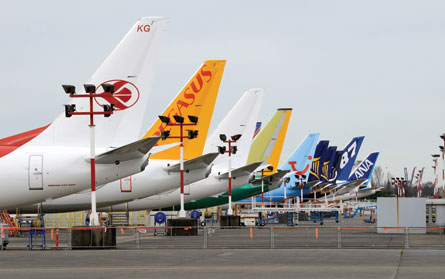If all goes according to plan, when 2014 dawns Boeing will move to a production rate under which it completes one commercial aircraft every 12h. The estimated annual total of around 720 commercial aircraft would be a record for the airframer, at more than 40% higher than the 485-500 deliveries forecast for 2011 and 154% above the output from 2004.
Production rates are being pushed up as a consequence of the Airbus-Boeing duopoly's desire to thwart new entrants, combined with a general aerospace market upswing. "We're sold out on the 737 through 2015; we're sold out on the 787 through 2019. And one of the biggest challenges that we have is having the slots for our customers, and that's why we're going up in rate," says Jim Albaugh, chief executive of Boeing Commercial Airplanes.
The 737 line stoppage of 1997 remains a fresh memory, cautioning that a production ramp-up can be terribly costly if pushed too hard, too fast and without appropriate oversight.
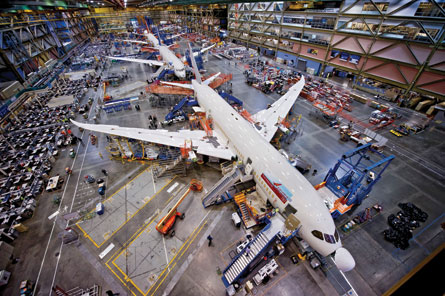 |
|---|
©Boeing |
Boeing aims to achieve 10 Dreamliner a month by the end of 2013 |
However, a more recent example of costly production woes guides Boeing's approach to ramping up its commercial output. The Boeing 787's supply chain has proved a trial by fire for the company since 2007, delaying the Dreamliner's deliveries by three-and-a-half years and pushing its first production plateau four years to the right while it absorbs the astronomical costs of the delays.
"What you end up realising is, you need more cost to supervise outside factories" outweighing the benefits of outsourcing design and manufacturing on the 787, says Boeing chief Jim McNerney.
"You need more insistence on commonality of IT tools, and you need more insistence on [supply chain] integration. And we just booted it. And our only defence is that every industry I know boots that once and then they learn. And unfortunately, we paid billions upon billions in the learning process there."
Steven Udvar-Hazy, chief of Air Lease, says the high cost of the 787 programme will mean rate increases are one way to pay for its cost overruns: "I think Boeing will build as many 737s as the supply chain allows. Why? They need the cashflow from the 777 programme and the 737s and they've got a very long backlog."
Udvar-Hazy believes there is as much a "financial motivation" as a demand driver to raise the rates, calling the situation a "win-win", with its customer base eager to take early delivery of aircraft on order.
As it looks to take advantage of the rising cashflow that comes with increased output, Boeing must engage its supply chain of 5,400 companies in a game of four-dimensional chess that takes into account impacts on its other programmes, its competitor's programmes, adjacent industries and forecasted changes in a global marketplace.
To apply lessons learned from the 787, Boeing seeks an unprecedented level of visibility across its supply chain - pushing 787 output up 400% between now and the end of 2013, when three lines in two states will be delivering 10 aircraft a month, to ramp the airframer's entire commercial operation to unprecedented levels.
Boeing plans to move from 31.5 737s a month to 35 in early 2012. Then it aims for 38 in the second quarter of 2013, and from two to 10 787s a month by the end of 2013, from seven to 8.3 777s a month by the first quarter of 2013, from 1.5 to two 767s a month in mid-2011, and from 1.5 to two 747s a month in 2012.
NEED FOR PARTS
In the airframer's history, obstacles to an efficient final assembly and delivery operation have almost always centred on the health of the supply chain and its ability to keep pace with Boeing's need for parts that do not require unplanned work after delivery.
The extraordinary growth is being managed methodically, says Larry Loftis, 777 programme vice-president and general manger.
"We've been very deliberate on how we've timed our production rates to allow the supply chain to absorb, let's say, a 767 rate increase and get a few months to stabilise and then put the next rate on," says Loftis, adding that planned rate increases take account not just of Boeing's needs, but also of industry-wide ramp-ups at Airbus, Bombardier and Embraer and at suppliers that have portfolios extending beyond aviation.
In the wake of the 787 supply-chain challenges, Boeing set up the Production Integration Center, which launched in December 2008 as mission control for the Dreamliner's global supply chain. The facility, which overlooks the 787 final assembly line in Everett, Washington, monitors moment-by-moment changes at suppliers of the highest and lowest tiers through a seamless network of digital telecommunications equipment.
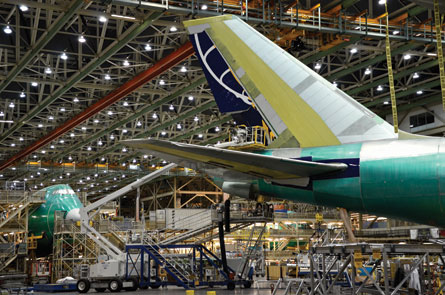 |
|---|
Flightblogger |
Following assembly of the last 747-400F, Boeing adapted the line to accommodate the new variants |
That model has proved more successful in stabilising the 787's supply chain with declining travelled work and a reduced level of design changes stemming from flight testing. Boeing is now steadily building at a rate of two 787s a month. For its other programmes, the airframer has established a "virtual" centre dubbed the Production Readiness Assessment, and deployed Boeing personnel across its supply chain to ensure a smooth ramp-up.
"We work closely with the major commodities of each supply chain to make sure we understand exactly where they're at in coming up to rate and we're getting more detail and - quite frankly - using a lot more of our on-site expertise with those suppliers," says 737 vice-president and general manager Bev Wyse.
"We're also looking at it a lot more holistically than we have in the past," adds Wyse. "So, taking into account not only all the Boeing programmes, not only the industry issues, but opportunities, the growth on other industries that may still touch our second tier, third tier or raw materials, the processing houses. We've really expanded our view, and really through these next few rate breaks we've got a high confidence that we'll be able to execute."
Taking advantage of its massive backlog of initial orders for the Next Generation 737, Boeing sought to advance Renton output to 21 737s a month by the end of 1997. The 737 Classic line was still running, but had pulled back from its peak output of 21 a month to 14, with 737NG production rapidly doubling from seven at the end of that year to 14 by the second quarter of 1998, and 21 a month - or one a day, based on the manufacturing calendar - by the close of 1998. Production of 737 Classics slowed from 14 to 10 in April 1998 and to three aircraft a month by the fourth quarter, eventually ending altogether at the end of 1999.
With the steady decline of the Classics and the steep ramp-up of the NGs, early October 1997 brought a complete freeze in 737 production, "rebalancing" work throughout its supply chain - aimed at incorporating design changes found in flight testing and ensuring that work arrived in Renton completed - halted the 737 line for nearly two months as aircraft at various states of completion dotted the assembly and flightlines.
Given the initial programme accounting quantity of 400 - identical to those of the 747, 757 and 767 programmes - the production debacle resulted in a $1.05 billion loss spread across all 400 aircraft.
Loftis jokes that he credits his greying hair to the 1997 episode, which he attributes to the 1995 recession and market downturn.
"We pulled a lot of work from our supply chain back into Boeing to stabilise the employment and stabilise the statement of work within Boeing - so that coming out of that downturn in 1995 we had significantly weakened our supply chain," Loftis says. "We had a number of suppliers that, when we asked them to ramp back up the rates, were no longer there or no longer helping to ramp up the rates quickly."
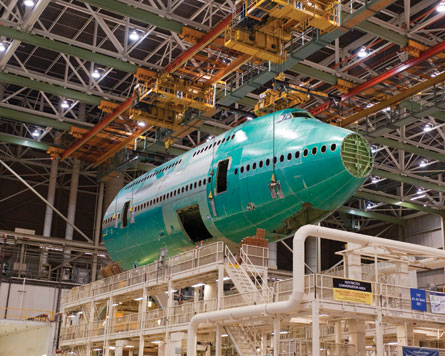 |
|---|
© Boeing |
Rising high: the forward fuselage of the first 747-8I takes shape in 2010 |
Given the 3,600-plus deliveries of 737NGs since 1997, the initial loss on the programme was a painful early chapter for the type, which today is the company's cash cow and a model of lean manufacturing, with its moving final assembly lines bringing together 200,000 parts simultaneously, 31.5 times every month.
The 1997 slant line would be unrecognisable from the 2011 moving line. The transition was completed in 2002, allowing the Renton facility to jump from 28 737s a month to 31.5 of the twinjets a month.
Central to the increasing rate are improvements and expansions in the company's industrial infrastructure. Wyse says the linear increase in rate over the next 24 months will be achieved through a combination of capital changes and a 1,200-person increase in staffing.
Boeing will reconfigure the second of its two side-by-side 737 assembly lines to match the production build plan and capacity of the first.
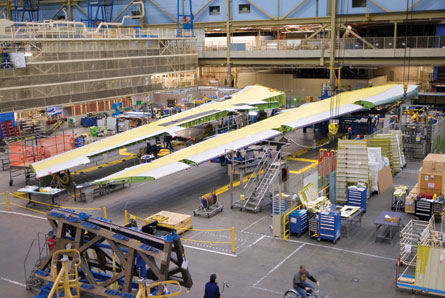 |
|---|
© Boeing |
The first set of 747-8 wings take shape in 2009 |
"That will actually give us capacity in our final assembly line of up to 42 a month on site. And there are even things we can do to go beyond that if we decide to," says Wyse.
Even with more than 2,100 orders for the 737 outstanding, "quite frankly what we're trying to do is continue to position ourselves so we're in front of customer demand", says Wyse - a subtle nod both to offering earlier delivery slots than Bombardier's for the CSeries and to the forecasts for narrowbody aircraft demand.
Additionally, in May, crews began preparing the land on which a new 7,000m² (75,000ft²) building will be built to support the ramp-up. The new 4-68 building in Renton is intended to free space inside final assembly and will accommodate preparation of buyer-furnished equipment such as seats and galleys. The facility, expected to be completed by the end of the year, will "accept equipment delivery, process the parts, complete inspections and deliver them shipside just in time for installation", says Boeing.
A newer, expanded wing systems and installation area will accommodate the higher rate.
In the near term, Boeing has been incorporating design changes into its already flowing line, adding two new customers a month for its all-new Sky Interior, incrementally introducing the upgraded bins, lighting and cabin management system rather than opting for a definitive blockpoint. The interior remains an option for those 737 customers who ordered narrowbody aircraft before its April 2009 launch.
Further, Boeing and CFM International are set to transition from the CFM56-7B engine to the upgraded -7BE, offering a 1% improvement in fuel burn along with a host of other drag clean-ups that bring an additional 1%.
Compared with its already cash-generating production lines, Boeing's 787 production ramp-up remains as steep a hill to climb as any clean-sheet design in commercial aerospace history. The challenges in achieving such a ramp-up are evident in mid-2011 when matching the programme's current output against the airframer's original plan of delivering 112 787s by 31 December 2009.
That plan, revised down to 109 aircraft in late 2007 in the midst of the worst of the supply chain and development woes, was to be executed on a single final assembly line. By April 2008, Boeing had pushed its ramp-up to 10 aircraft a month by the end of 2012, sliding that target again in August 2009 to the end of 2013.
THREE LINES
Three-and-a-half years since the first delay was announced in October 2007, the single final assembly line goal of 10 aircraft a month will be spread across three lines in two US states. Boeing's primary final assembly line in Everett is currently flowing at two aircraft a month, with plans to accelerate to 2.5 during July, August or September, with the ultimate goal of achieving 10 deliveries a month by the end of 2013, a 400% increase in production over the next 30 months.
 |
|---|
© Boeing |
Boeing plans to boost 777 production from seven to 8.3 a month by the first quarter of 2013 |
Scott Fancher, 787 vice-president and general manager, says the rate-brake decisions will be made every six months, stepping up to a higher rate four to five times before reaching 10 a month. But he cautions that timing is not the primary concern: "I really do want to emphasise... that decision [to increase rate] is really not about time and not about step; it's about maturity of the production system and its ability to consume the work that's flowing through the production system."
Supporting the primary line will be the new billion-dollar final assembly facility in North Charleston, South Carolina, set to be operational in July, ramping to three aircraft a month. In Everett, the newly relocated 767 line will be replaced by the 787 surge line, operational in early 2012.
Boeing had intended to advance the 787 line beyond two aircraft a month in 2010, although design changes and rework on items such as doors, flaps and the Alenia Aeronautica-built horizontal stabiliser prompted a halt to deliveries on four separate occasions.
PACE OF PRODUCTION
"There is no question the ramp is challenging," said McNerney of the pace of production in 2010. The 10-a-month target "was going to finish earlier than the end of 2013 by our internal plan, but that's largely eroded at this point with the slide".
As the assembly factories ramp up, Boeing will accelerate its change incorporation operations in Everett and San Antonio, Texas, bringing each example up to a final configuration when the aircraft is certificated by the Federal Aviation Administration in August or September. Boeing has established a "second factory" on its Paine Field campus inside a massive five-bay maintenance, repair and overhaul hangar owned by Aviation Technical Services. Boeing ATS, or "Factory South" as it has been dubbed, has grown steadily since its first limited use as a site to conduct side-of-body reinforcement on the 787 test fleet in 2009.
In March, Boeing appointed Tim Coyle to run Boeing ATS. He led the industrial integration of the North Charleston site after Boeing bought out suppliers Vought Aircraft Industries and Alenia Aeronautica in 2008 and 2009. Coyle is tasked with wiping out 140,000 open assembly jobs on dozens of 787s at various state of completion occupying the flight line, closed taxiways runways and ramps at Paine Field.
The five slant bays will eventually be designated with a unique task, focusing on structures, wiring, systems, interiors, finishing and aqueous wash and aircraft close-out, with staff, working three shifts, expected to number more than 1,200. The role of Boeing ATS will be significant heading through 2012 as earlier aircraft are completed
McNerney emphasises that Boeing's extensive 787 rework is factored into its 2011 delivery plan, which has a mix of newer and early 787s in the delivery stream of 12 to 20 aircraft, including ZA101, Airplane Eight - the first that is to be delivered to All Nippon Airways.
Further, Boeing activated its San Antonio change incorporation in March, ferrying the first of six initially planned aircraft to the facility. ZA117, the first 787 for Japan Airlines, activated the facility in March, while RC503, the first 747-8F for Cargolux, moved out of flight test to San Antonio in May.
The North Charleston line is Boeing's first major commercial expansion outside the US Pacific Northwest, and its first all-new assembly facility since the 1966 construction of the 747 line. That facility grew over three decades to house the 767, 777 and 787 lines.
Boeing received its initial certificate of occupancy from the city of North Charleston on 16 May, giving the go-ahead for the airframe to begin moving into the facility, and conducted its official ribbon-cutting on 10 June.
Still yet to be completed are the facility's flightline and delivery centre, although Boeing will proceed with a jig loading readiness review in June ahead of the loading of the first 787 in July.
Under the solar panel-covered roof of the massive new factory, Boeing has built an eight-position horseshoe line with a main door twice as wide as the 90-105m (300-350ft)-wide doors in Everett.
By comparison, the primary Everett line uses only four positions, underscoring the potential for the Charleston line to expand output far beyond the planned rate of three 787s a month. Once the line is operational, Boeing will ferry each aircraft to Leading Edge Aviation Services for final painting and livery application at the company's factory in Amarillo, Texas.
Even as Boeing ramps up for record rates on its 787, one Wall Street analyst suggests a quiet threat to the programme may be festering.
In the extraordinary growth of orders between 2004 and 2008 anchored by high demand and low prices, airlines may have over-ordered 787s to the tune of nearly 500 aircraft, says UBS Investment Research.
FUTURE GROWTH
"Specifically, we identify 46 787 customers that we estimate are over-ordered by nearly 500 aircraft on net, even after assuming future growth at high levels and significant replacement demand," says a report authored by UBS analyst David Strauss.
"We see 787 as over-ordered across all regions, with 2015-16 deliveries appearing most at risk. Over the past year, we have seen 787 deferrals from Korean Airlines, Air China, ANA and Vietnam, along with cancellation by DAE Capital of all 15 of its 787 orders.
"787 customers that we see as most over-ordered include Gulf Air, Qantas, Air China, ANA, United, ILFC, Singapore and Air Canada, among others," says Strauss.
UBS lays out the consequences to 787 profitability plainly: "Boeing is depending on a large programme accounting block size over which to spread its costs and any reduction of the block size would result in higher costs per unit. In addition, cancellations or deferrals could trigger a slower-than-expected production ramp that would yield lower productivity across its accounting block."
777 Boost
Sandwiched between the 787 line and the coming surge line sits Boeing's moving 777 line, advancing structural sections at a near imperceptible rate of 51mm/min (2in/min).
Today, inventory on the line is 40-50% lower than its previous peak of seven aircraft a month. Despite a 25% increase in Boeing's staff to return to that rate, growth is running 20% lower than in the first climb to seven a month in July 1997, says Jason Clark, head of 777 manufacturing.
Clark says steady investment in lean manufacturing has cut flow time from 67 days, six years ago, to 52 days, at a rate of five 777s a month, and down to 49 days when it returned again to seven a month in May.
With rates heading to 8.3 777s a month in 2013, or 100 aircraft a year, Clark hopes to cut that flow time by an additional 25%.
That is to be achieved through use of additional automation to cut man-hours by 5% to 10% on circumferential and lap drilling on fuselage sections.
Albaugh says that the line is sold out until 2015, with many slots already filled in 2016, 2017 and 2018.
He hopes to sustain the high 777 rate for at least two years, balanced against 4.5 to five years of backlog, and would be "surprised" if the rate pushed higher than 8.3.
© Flightblogger |
Production of 737s runs at 31.5 a month |
As of late May, Boeing held 282 777 orders, a figure that will seemingly be rapidly churned through with the coming increases in production. However, Boeing insists that natural market demand for twinjets is on the rise. The company has added 61 new orders to its backlog in 2011.
Further, Loftis acknowledges that schedule concerns from Airbus A350 XWB customers are leading the US airframer to position itself to supply interim lift if the Airbus programme is delayed.
"I think there may be some of that demand we see of people wanting to make sure they've got positions in 2014 and 2015, and maybe 2016," he says.
Loftis adds that there is "probably a little concern" in the marketplace of the timing of the A350, "but right now the predominant part of that [is that] there is need for lift in the marketplace over the next three or four years that people need to be filled".
McNerney says that the 777 is going to be the unexpectedly strong story of this decade, adding that until the A350-1000 has more technical and schedule clarity, "I think we're going to sell a heck of a lot of 777-300ERs".
Following the assembly of the last 747-400F, Boeing adapted the 747 line to accommodate the two newest members of the 747-8 family. Accelerating from 1.5 to two 747-8s a month in 2012 with the addition of the 467-seat -8 Intercontinental - now in its certification campaign - Boeing has again encountered an increasing level of travelled work and design-change incorporation coming out of flight testing.
As a result, Boeing held its 747-8 line in place from 6 May until 7 June, allowing it to catch up on design changes as it introduced the -8I into its production system.
"As sometimes happens during introduction of a new minor model, the process of starting up the regular production of the 747-8 Intercontinental has created some challenges best addressed at this early stage in the ramp-up," says 747 vice-president and general manager Elizabeth Lund.
Boeing used the four weeks to rebalance the work across the 747-8 line "so that we can complete some unfinished work, incorporate design changes driven by discoveries in flight test and make sure we have a healthy production line as we move up in rate next year".
The company is keenly aware of the need to avoid a repeat of past production issues. The 1997 production debacle forced the 747-400 line to be shut for several weeks for a similar rebalancing.
"Rebalancing work is a tough challenge, but it's a proven approach and the right thing to do now to make sure we deliver the best airplanes to our customers, with the highest quality possible today, and to maintain that quality as we move up in rate next year," adds Lund.
Boeing aims to deliver the first 747-8F in the middle of this year to Cargolux and its first 747-8 VIP to a completion centre at the end of the year.
While Boeing cannot control the global economy or the external events that can so easily knock the airline industry off course, what it can manage is the decisions it makes during a period of economic expansion.
Undertaking one of the largest production expansions in its history will require demand to be sustained and its supply chain to maintain its readiness.
SUCCESSFUL
"Boeing will only be successful if our supply chain is successful," says John Byrne, director of common commodities supplier management for Boeing Commercial Airplanes.
"We have 10 separate rate brakes coming at us. Every rate brake is an opportunity for each and every one of us to experience problems," he said in February to a group of suppliers. He added: "It doesn't do any good if Supplier A has everything perfect and Supplier B doesn't, because then I can't build airplanes.
"We have to have the full supply chain aligned, which means there's a tremendous amount of collaboration and there's a tremendous amount of information sharing that has to go on. In that way, that's what allows our supply chain to begin to achieve that competitive advantage."
For the latest twist and turns in Boeing new-product development.
Source: Flight International





















